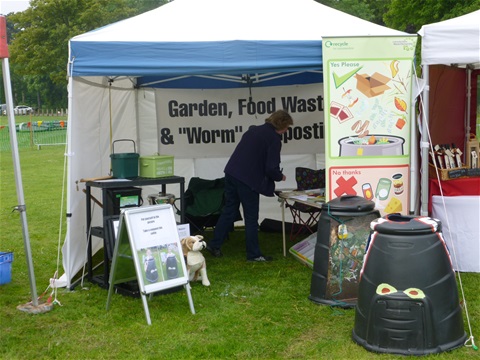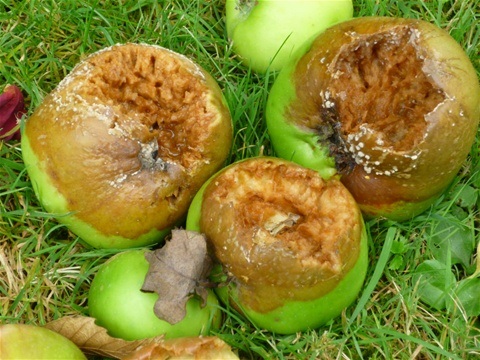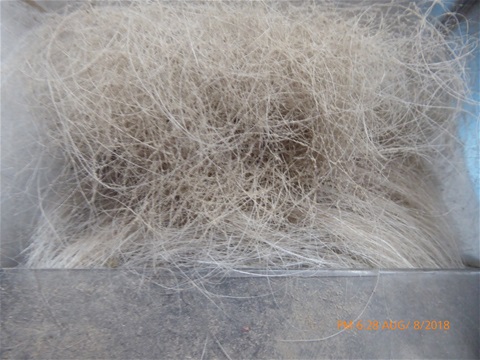Hot Composting Apples
It is becoming customary to celebrate Apple Day with the communal pressing of apples to make juice or drying them to make apple chips Many of the windfalls will not be suitable to eat or drink,but could
be composted, and I felt it might be useful to expand the advice I have previously given on composting apples.
Apples and other fruit such as pears, banana skins, strawberries, peaches and all melons, can normally be added to the composting
or worm bin as and when they are no longer suitable for eating and this includes the occasional windfall during the summer months. Chopping the apples will of course speed the composting process.
Hot Composting Apples
Where there
are a lot of apples I believe it is best to use a bin and to layer them with browns and continue making alternate layers of apples and browns until all the windfalls have been used. If you only have a few trees it might be better to collect the apples in a
storage container i.e. a bucket or bin so that you have enough to make several layers about 4” thick at the same time. If possible, other greens should be added at the same time as the chopped or pulped apples to introduce air spaces and variation into
the green mix.
Creating the correct green brown ratio is important to prevent the apples fermenting and producing an unpleasant smell. One-part green to two-part brown material is traditional recommended although many composters settle for about
equal quantities. The RHS suggest that apples should be no more than 20-25% of the total compost material. ( https://www.rhs.org.uk/advice/profile?pid=444). Layering is not essential but in
dealing with a large amount of fruit it does make it easier to get the initial green/brown balance right.
Although autumn leaves are normally used to make leafmold they do make an excellent component of the brown layer when dealing with fruit.
Sawdust from a vegetarian pet, or chicken can also be added. I also add shredded computer paper
A shovelful of finished compost from an adjacent bin, garden soil or manure can also be added to kick start the microbial activity that will turn the
apple waste into quality compost. As with most hot composting systems water the bin or the browns at the start of the process and at any time that it looks dry. Turn the compost mix to aerate it and cover with browns as this will reduce any smells from
the bin and reduce numbers of fruit flies when the lid is removed, or heap uncovered
For the first week the material benefits from being turned daily to aerate the mix ensuring that microbial activity heats the content. When aerating move
the material on the outside of the pile toward the centre. Reduced frequency of mixing as the effect decreases. (See the section on hot composting) if you have a thermometer monitoring the temperature it can provide additional interest (especially for children).
Do continue to check the compost condition weekly. If it becomes to dry it will stop working while if too wet anaerobic bugs will take over and the temperature will fall, and the smell will increase. If dry add water a little at a time, if wet add
more browns e.g. dry leaves. After two or three months the compost should be finished dark brown in colour with an earthy smell and no apples identifiable.
Cold Composting Apples
If you have fewer apples and
intend to add them to a bin already in use a simplified technique can be used, If the apples are whole chop the apples with a spade and add to the bin to make a layer two or three deep. Cover this with a wet leaves, bedding from vegetarian pets, rough compost
or old straw. Repeat the process adding apple and brown layers until the apples have been used. Finish with a layer of browns to reduce odours and insect pests. Using this cold composting process, it may take up to two years to produce good quality compost.
Diseased fruit
Often windfall apples will be diseased and although cold composting will not reach temperatures that necessary to kill the more persistent pathogens, they are suitable for disposing of material infected with fungal diseases
such as powdery mildews and rusts.
Apple Scab is caused by a fungus that infects both leaves and fruit it is not suitable for cold composting, but it will not survive hot composting at above 60-70C
In some countries the apple maggot, is a problem and its spread can result from
cold composting at home or on the allotment. If apple maggot is a problem in your area check the apples before adding them to the bin. Infected fruit will show damage throughout the flesh and turn brown and mushy as the maggots burrow throughout
the apple for up to up to 30 days. This widespread damage enables apple maggot infection to be distinguished from that caused by the more common codling moth, which burrows straight to the apple core leaving most of the fruit undamaged.
Apples
that appears to have maggot damage it should be bagged in plastic bags and sent to a landfill. There is more detailed information at Washington State University, Whatcom County Composting Factsheet
which is available at: http://whatcom.wsu.edu/ag/compost/images/fact_sheet.gif
More information on composting apples can be found at www.carryoncomposting.com
The next blog will be a short update on composting apple pulp


